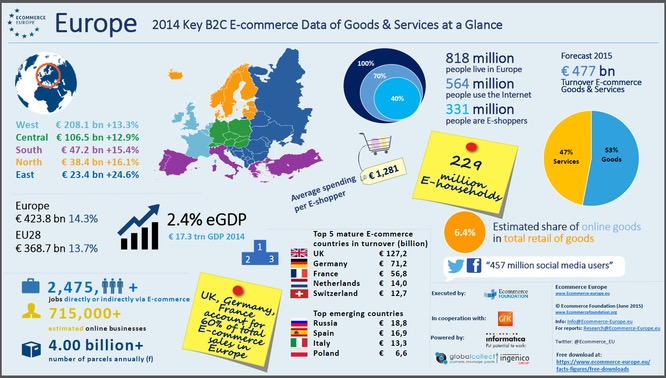While the European Commission debates how to overcome obstacles to cross-border online shopping, Europe 500 web merchants like Amazon and Zalando are simply doing it.
The effort announced this week by the European Commission to forge a true common online market among the 28 states of the European Union could take years to bear fruit, if it ever does. But some of the top online retailers in Europe aren’t waiting around for regulators to act, and are finding many Europeans are already willing to shop across border.
The European Commission, which sets policy and manages compliance on a wide range of issues, has launched an antitrust probe into whether companies are creating artificial barriers that prevent European online consumers from shopping more across national borders.
“European citizens face too many barriers to accessing goods and services online across borders,” says Margrethe Vestager, the European commissioner overseeing antitrust issues. “Some of these barriers are put in place by companies themselves and with this sector inquiry my aim is to determine how widespread these barriers are and what effects they have on competition and consumers.”
The European Commission isn’t saying just what companies—including any U.S.-based retailers and e-commerce companies—it is targeting. But big U.S. companies are likely to come under close scrutiny, based on the ongoing antitrust investigation of Google Inc. and national probes into Facebook Inc.’s privacy policies. In mid-April, the European Union escalated its four-year-old probe into Google Inc., accusing the Internet giant of abusing its dominance of the search-engine market and starting a new investigation into its Android mobile-phone software.
From our partners:
There are indications that businesses may themselves establish barriers to cross-border online trade, with a view to fragmenting the EU’s single market along national borders and preventing competition,” Vestager says. “Those barriers may include contractual restrictions in distribution agreements that prevent retailers from selling goods or services purchased online or cross-border to customers located in another EU country.”
[/infobox]What’s clear is that Europe is a big e-commerce market, but still one largely fragmented along national lines.
Collectively Europe is the world’s second-biggest regional e-commerce market behind China and ahead of the United States. In 2014 European e-commerce grew 16% to reach $410.97 billion, according to trade group Ecommerce Europe. In comparison e-commerce in China last year grew 49.7% to $449.12 billion says China’s National Bureau of Statistics while the U.S. Department of Commerce estimates e-commerce in the U.S. grew 16.2% in 2014 to $304.91 billion.
But the EU is concerned that a true single market has not yet emerged in e-commerce, as most consumers limit their online purchases to retail web sites in their own country. Of the 264 million online shoppers in Europe only about 22%, or 58.1 million, in the last three months have bought online outside their own country, estimates Forrester Research. Cross-border e-commerce only accounts for about 17%, or $42.6 billion, of the combined e-commerce sales of $250.90 billion of France, Germany and the United Kingdom, Forrester says. These three countries are represent Europe’s biggest and most-established national online retailing markets.
That 17% is about the same number as in 2013, says Forrester analyst Michelle Beeson, who covers European e-commerce. “Europe remains more of a series of national markets than a single market,” Beeson says. “There’s countries with different red tape to contend with, differing payment structures and marketing, and shopping tastes that vary per country.”
But some companies aren’t waiting around for the European Commission and are already selling across borders in Europe. Notable among them is No. 1 in the Internet Retailer 2014 Europe 500. “Amazon has approached Europe as a single market since we launched here more than 15 years ago,” says Amazon director of European Union seller services Francois Saugie. “European businesses are able to sell on any of our websites, to any customer, anywhere in Europe.”
Cross-border sales on the marketplace section of its European sites also are growing Amazon says. In the past year Amazon says that businesses selling on the marketplace sections of its European websites in France, Germany, Italy, the Netherlands, Spain and the United Kingdom generated total sales of $3.08 billion. Amazon didn’t share figures for the prior year or disclose other numbers, such as how much marketplace sales represents of its total European sales.
Meanwhile, Amazon is also generating strong growth in the six countries where it operates localised web sites: the United Kingdom, Germany, France, Italy, Spain and the Netherlands. For example, in Germany and the United Kingdom, where Amazon has been selling online since 1997, web sales increased 13.1% to $11.91 billion and 14.4% to $8.34 billion, respectively.
Amazon says years of building up its fulfillment and distribution network in Europe, taking a local approach in each European country, and e-commerce technology features such as one-click checkout have helped build its European business. Amazon now has 28 fulfillment centers across Europe and offers across much of Europe Amazon Prime, its subscription fulfillment service that features free two-day shipping and other perks such as free digital entertainment streaming.
European retailers are also pursuing the opportunity to sell to online consumers across Europe. Appealing to cross-border shoppers, especially younger shoppers that prefer to shop on mobile devices, is a top priority for Berlin-based, web-only shoe and apparel retailer Zalando SE (No. 9 in the Europe 500). Zalando says sales grew about 26% in 2014 to reach $2.53 billion from $2.01 billion a year earlier. And the fastest growth came outside of Zalando’s three core markets of Germany, Austria and Switzerland. In those countries, where many consumers speak German, sales grew 24% to $1.39 billion in 2014. But web sales from the rest of Europe grew faster, up 31.1% to $934.9 million.
This feature originally appeared in Internet Retailer.


















